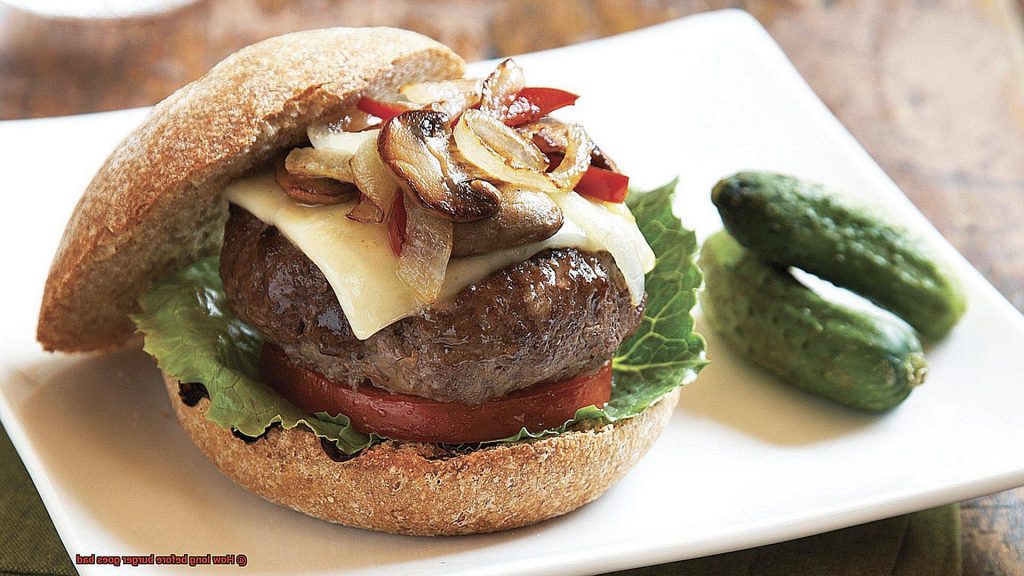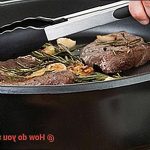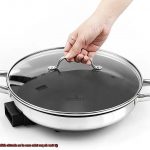Are you a self-proclaimed burger aficionado? There’s nothing quite like the satisfaction of biting into a juicy, sizzling burger. Whether you’re indulging in a fast-food chain or grilling up patties in your backyard, one thing is for sure: freshness is crucial. But have you ever wondered how long before your beloved burger goes bad? It’s not a question that often comes to mind, but it’s one that deserves attention.
Let’s face it – burgers can spoil pretty quickly if not stored correctly. Raw meat can harbor bacteria within hours, and if left out at room temperature for too long, those pesky microbes can multiply and wreak havoc on your digestive system.
So, how long do we really have before our burgers become unsafe to eat? The answer depends on various factors – the storage temperature, meat quality, and any additional toppings or condiments added.
In this blog post, we’ll take a deep dive into the science of food spoilage. We’ll offer practical tips on storing your burgers safely and provide insights into detecting signs of spoilage. Get ready to sit back, relax and learn everything you need to know about keeping your burgers fresh and delicious.
Contents
The Type of Meat Used in Burgers
Ground beef is the go-to option for most people, but not all ground beef is created equal. The quality of the meat depends on various factors, including the animal’s diet, living conditions, and age at the time of slaughter.
If you want your burgers to last longer, it’s best to opt for higher-quality beef with a lower fat content. Fat content can affect how quickly a burger spoils since fat is more prone to oxidation and bacterial growth. To ensure that your burgers are safe and delicious every time, it’s essential to understand how to handle and store ground beef.
Ground beef is more perishable than other cuts of meat because it has been mechanically tenderized and exposed to air during the grinding process. This exposure makes it more susceptible to bacterial growth and spoilage. Therefore, it’s crucial to follow proper food safety practices when handling and storing ground beef.
Here are some tips for ensuring your burgers last as long as possible:
- Choose high-quality beef with a low fat content.
- Store your raw ground beef in the refrigerator at a temperature below 40°F (4°C) until ready to use.
- Ensure that all utensils and surfaces are clean when preparing your burgers to prevent cross-contamination.
- Cook your burgers thoroughly to an internal temperature of 160°F (71°C) to kill any harmful bacteria that may be present.
- Store cooked burgers properly in an airtight container in the refrigerator for up to four days or freeze them for up to four months.
It’s important to note that while higher-quality beef will have a longer shelf life than lower-quality beef, it’s still crucial to use your senses to determine if the meat has gone bad. If it smells sour or looks discolored or slimy, it’s time to throw it out.
How to Handle and Store Raw Ground Beef
Safe Handling and Storage of Raw Ground Beef for Delicious Burgers
Burgers are a popular dish, but handling and storing raw ground beef requires extra care to prevent bacteria growth that can cause foodborne illnesses. Here are five sub-sections that explain the steps necessary to handle and store raw ground beef safely:
Buy and Store Ground Beef Immediately
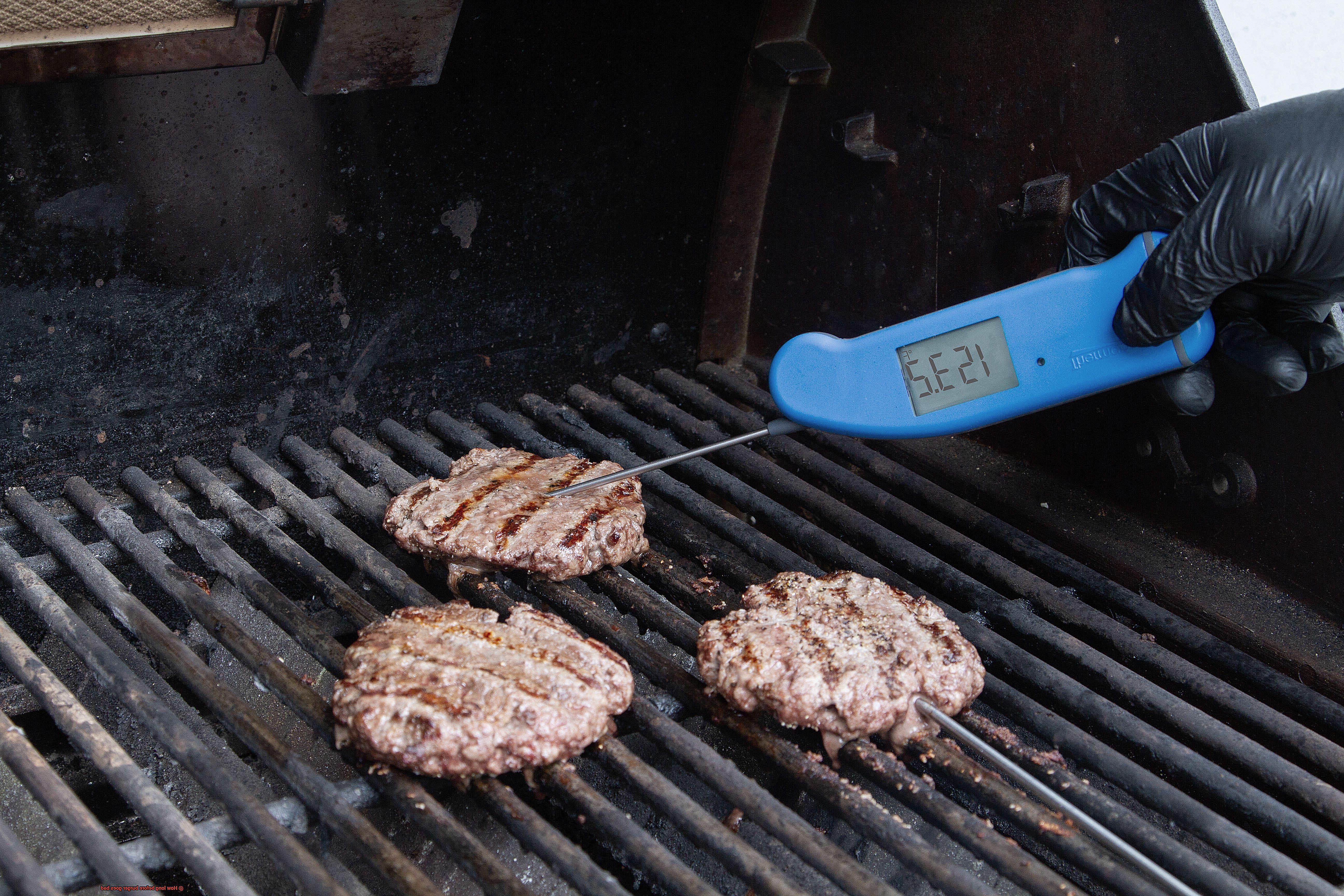
When purchasing ground beef, always check the sell-by date, and choose packages that are cold to the touch with no tears or holes. Once you bring it home, store it in the refrigerator or freezer immediately. Raw ground beef should be stored in the refrigerator at a temperature of 40°F or below.
Keep Ground Beef Refrigerated

To prevent cross-contamination, place the raw ground beef on a plate or in a container. If you are not planning on using the meat within two days of purchase, consider freezing it in an airtight container or freezer bag. Ground beef can be frozen for up to four months.
Thaw Frozen Ground Beef Safely
Thaw frozen ground beef safely by doing so in the refrigerator or microwave. Never thaw it at room temperature as this can allow harmful bacteria to grow.
Cook Ground Beef to a Safe Temperature
Cooking ground beef thoroughly is crucial to avoid potential bacteria growth. Heat it to an internal temperature of 160°F to kill any harmful bacteria present. Use a meat thermometer to ensure that the temperature has been reached in the thickest part of the burger.
Practice Good Food Safety Habits
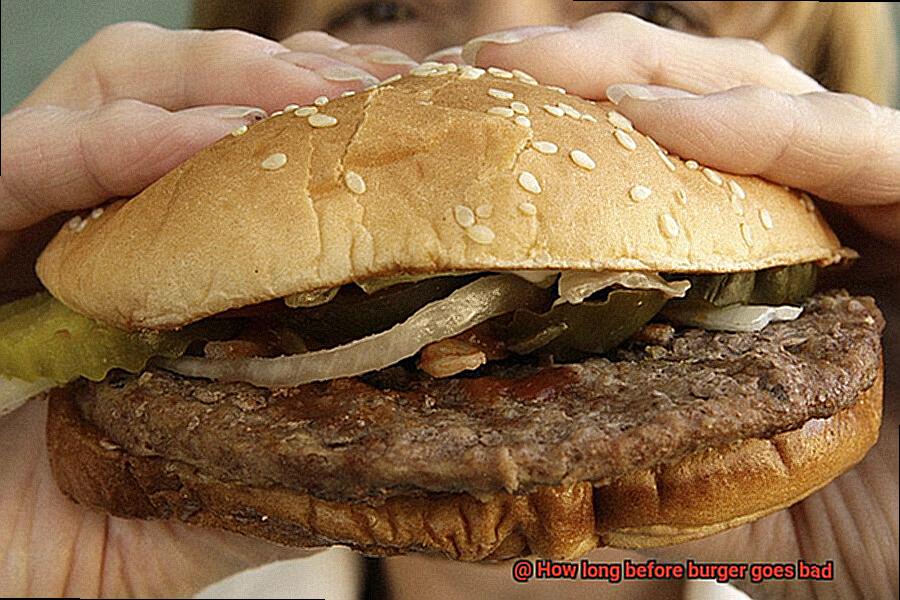
Always wash your hands before and after handling raw meat to prevent the spread of harmful bacteria. Additionally, ensure all utensils and surfaces that come into contact with raw meat are cleaned thoroughly to prevent cross-contamination. After cooking, refrigerate any leftovers promptly and discard any meat that has been left at room temperature for more than two hours.
The Different Cooking Methods for Burgers
We’ve done the research to bring you the best ways to cook your favorite dish. From grilling to broiling, we’ll explore each method’s pros and cons so that you can choose the one that works best for you.
First up, let’s talk about grilling. A classic choice and one of the most popular methods for cooking burgers, grilling allows for a delicious smoky flavor and charred exterior that many people find irresistible. However, cooking the burger evenly and preventing it from drying out can be challenging. To ensure perfection, invest in a meat thermometer to check for doneness.
Next, we have pan-frying. This approach involves cooking the burger on a stovetop in a pan with some oil or butter. Pan-frying gives you more control over the temperature, resulting in a juicier burger. However, it may not provide the same charred flavor as grilling. For best results, use a non-stick pan and cook the burger on medium heat for about 3-4 minutes per side.
Another option is broiling, which involves cooking the burger in an oven on high heat. This can be a quick and easy method but may not result in the same depth of flavor as grilling or pan-frying. If you decide to broil your burgers, place them on a broiler pan and cook on high heat for about 4-5 minutes per side.
Regardless of which method you choose, it is vital to ensure that the burger is cooked to a safe internal temperature of at least 160°F to prevent foodborne illnesses. Always use a meat thermometer to check the temperature of your burgers.
Shelf Life of Raw Ground Beef
Don’t let your meat go to waste. As an expert on the shelf life of raw ground beef, I have some tips to extend its lifespan and keep it safe for consumption.
The shelf life of raw ground beef is affected by multiple factors, including temperature, packaging, and storage conditions. To ensure your ground beef lasts longer, store it in the coldest part of your fridge – typically the back – at a temperature below 40°F (4°C). If you won’t use it within 1-2 days, freeze it immediately at 0°F (-18°C) or below.
Packaging is another critical factor to consider when purchasing raw ground beef. Always buy air-tight packaging that has not been damaged or punctured. Damaged packaging allows bacteria to enter and spoil your meat. Check for any damage before purchasing to avoid this problem.
The fat content of your ground beef also affects its shelf life. Higher-fat ground beef spoils faster than leaner types because fat provides an ideal environment for bacteria growth. To extend the lifespan of your meat, opt for leaner types of ground beef.
So, by following these tips and proper food safety guidelines, you can extend the shelf life of raw ground beef and prevent waste. To recap:
- Store your meat in the coldest part of the fridge at or below 40°F (4°C).
- Freeze unused meat immediately at or below 0°F (-18°C).
- Purchase undamaged, air-tight packaging.
- Opt for leaner types of ground beef.
Shelf Life of Cooked Burgers
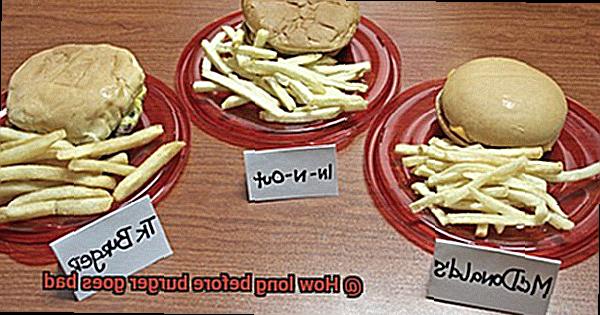
Let’s dive right in.
First and foremost, it’s crucial to understand the “danger zone.” This refers to temperatures between 40°F and 140°F, where bacteria can multiply rapidly. If a cooked burger has been left out at room temperature for more than two hours, it’s best to toss it out to avoid any potential foodborne illnesses.
Now, if you want to extend the shelf life of your cooked burgers, let’s talk storage. The key is to keep them in an airtight container or wrap them tightly with plastic before placing them in the coldest part of your fridge. With proper storage, cooked burgers can typically last up to four days in the refrigerator.
But what if you won’t be consuming your burgers within four days? Don’t fret – freezing is an option. Be sure to let your burgers cool down completely before placing them in an airtight container or freezer bag. Don’t forget to label the container with the date so you know when it’s time to use or discard the burger. When reheating frozen burgers, ensure they are heated all the way through to an internal temperature of 165°F to kill any bacteria that may have grown during storage.
Tips for Extending the Shelf Life of Burgers
Calling all burger aficionados. Are you tired of your burgers going bad before you can even enjoy them? Don’t despair. As an expert on the topic, I have some tips that will help you extend the shelf life of your burgers and keep them fresh for longer.
Proper Storage
The first tip is to store your burgers properly. Raw burgers should always be stored in the refrigerator at a temperature of 40°F or below. If you plan on storing them for more than a few days, consider freezing them instead. To prevent air from getting inside the packaging, wrap them tightly with plastic wrap or aluminum foil and place them in an airtight container or freezer bag. This will prevent bacterial growth and keep your burgers fresh for longer.
Use Vacuum Seal
Another way to extend the shelf life of your burgers is by using vacuum sealing bags. These bags are designed to keep air out, preventing any moisture from getting inside and causing the meat to spoil faster. Give it a try and see the difference it makes in keeping your burgers fresh and delicious.
Avoid Contamination
Proper handling of your burgers is essential to avoid contamination that can lead to spoilage. When preparing burgers, be sure to wash your hands and all utensils and surfaces used in the process. Store raw burgers separately from other foods, especially ready-to-eat foods like fruits and vegetables. Use separate cutting boards, utensils, and plates for raw and cooked meats to avoid cross-contamination.
Cook Burgers Thoroughly
Cooking your burgers thoroughly not only ensures they are safe to eat but also helps to extend their shelf life. The heat from cooking kills bacteria that may be present in the meat, preventing it from spoiling quickly. Use a food thermometer to ensure that your burgers are cooked to at least 160°F.
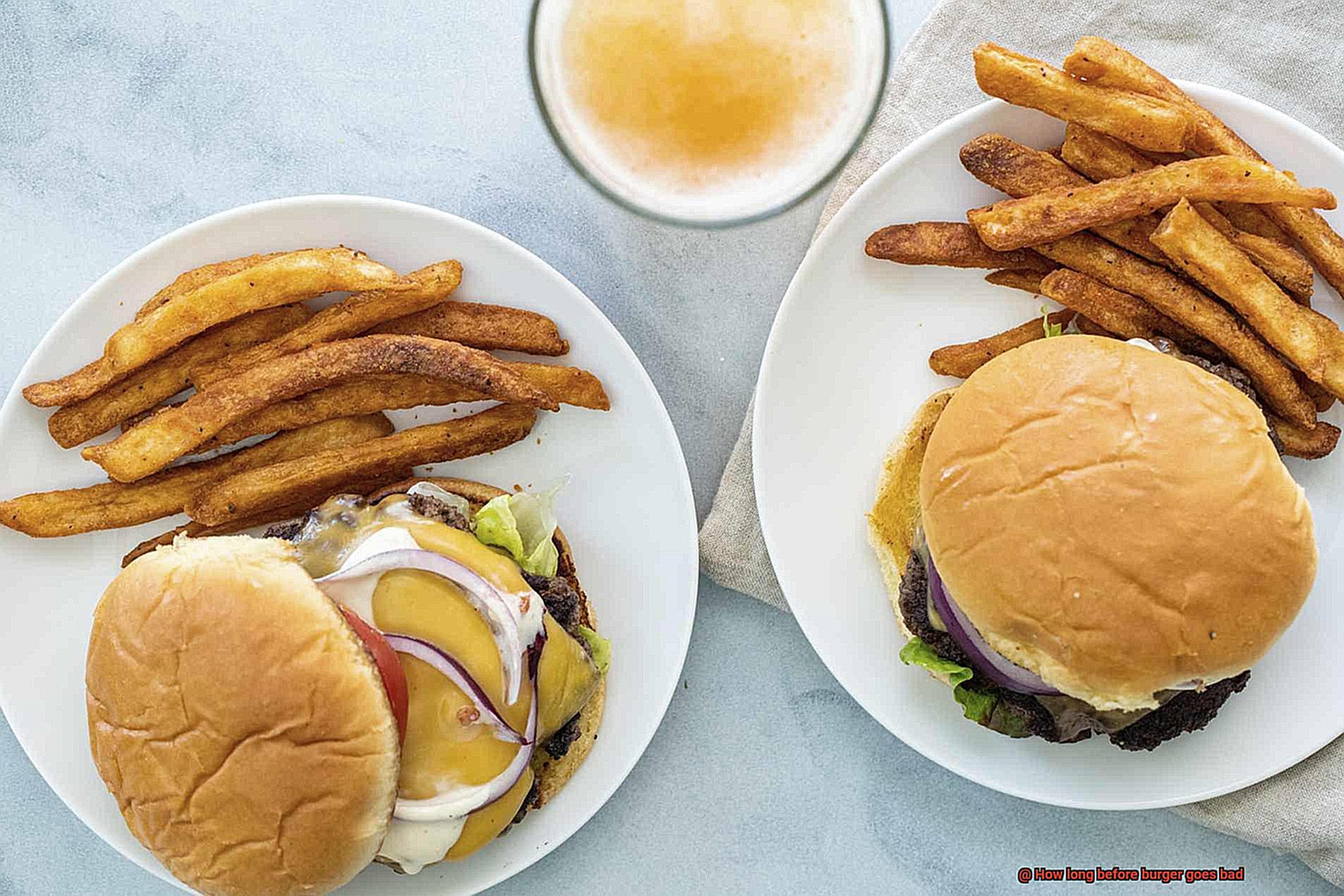
Freeze if Not Consumed
If you have leftover burgers, it’s best to freeze them rather than keeping them in the refrigerator for an extended period. To freeze burgers, wrap them tightly with plastic wrap or aluminum foil and place them in an airtight container or freezer bag. Be sure to label the container or bag with the date so you know how long they’ve been frozen for.
Common Food Safety Practices for Handling Burgers
Burgers are an all-time favorite comfort food for many, whether enjoyed at a family barbecue or a quick lunch. However, amidst the excitement of preparing burgers, it’s crucial to prioritize food safety to prevent foodborne illnesses. Luckily, there are several common food safety practices that you can follow to ensure safe and delicious burgers.
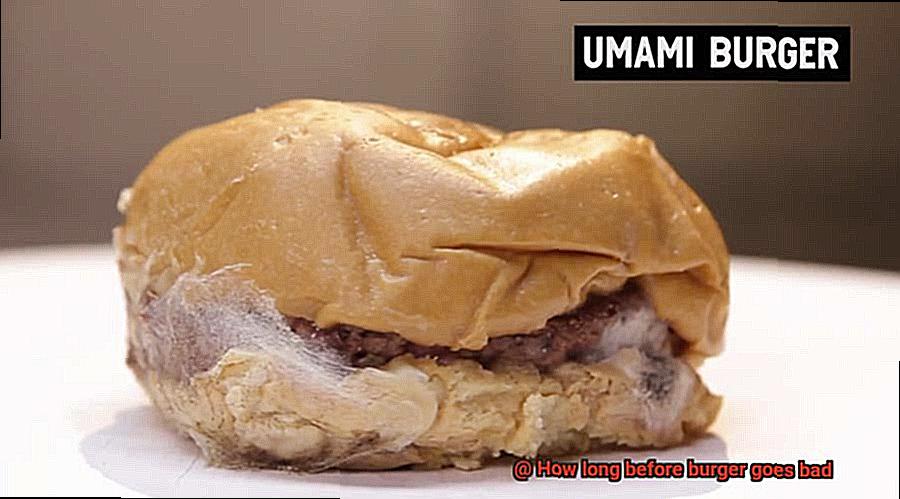
Starting with the basics, clean hands are a must when handling burger meat. Thoroughly wash your hands with soap and water before handling the meat to remove any bacteria or germs that could contaminate it.
Storing raw burger meat at a safe temperature is also essential. Aim to keep the meat below 40°F (4°C) to prevent the growth of harmful bacteria and store it separately from other foods in the refrigerator to avoid cross-contamination.
When preparing the burgers, using separate cutting boards, utensils, and plates for raw and cooked meat is critical. This helps prevent the spread of harmful bacteria that can make you sick.
Cooking burgers to the correct temperature is also key to ensuring food safety. The internal temperature of a burger should reach 160°F (71°C) to kill any harmful bacteria that may be present in the meat. Use a food thermometer to ensure that the burger has been cooked thoroughly and until no pink remains.
Finally, when dealing with leftovers, proper handling is necessary. Cooked burgers should be refrigerated within two hours of cooking and consumed within three to four days. Before consuming leftovers, make sure to reheat them to an internal temperature of 165°F (74°C).
Conclusion
To truly savor a burger’s juicy goodness, you must prioritize its freshness and safety. The longevity of this beloved dish is dependent on several factors: the type of meat, storage conditions, packaging, and cooking techniques. Ground beef, in particular, is highly susceptible to bacterial growth and spoilage due to its exposure during the grinding process. Therefore, proper handling and storage procedures are essential.
When grilling up burgers, it’s crucial to ensure that they are cooked thoroughly to an internal temperature of 160°F or higher. This step ensures that any harmful bacteria lurking within the meat are eliminated before consumption. Additionally, storing both raw and cooked burgers at safe temperatures is pivotal in extending their shelf life.
As with any food item, following basic food safety practices such as washing hands before handling meat and using separate cutting boards for raw and cooked meat can significantly reduce the risk of foodborne illnesses. By taking these precautions seriously, you can indulge in mouth-watering burgers without compromising your health or taste buds.
As a self-proclaimed burger enthusiast, understanding the science behind food spoilage is paramount.

